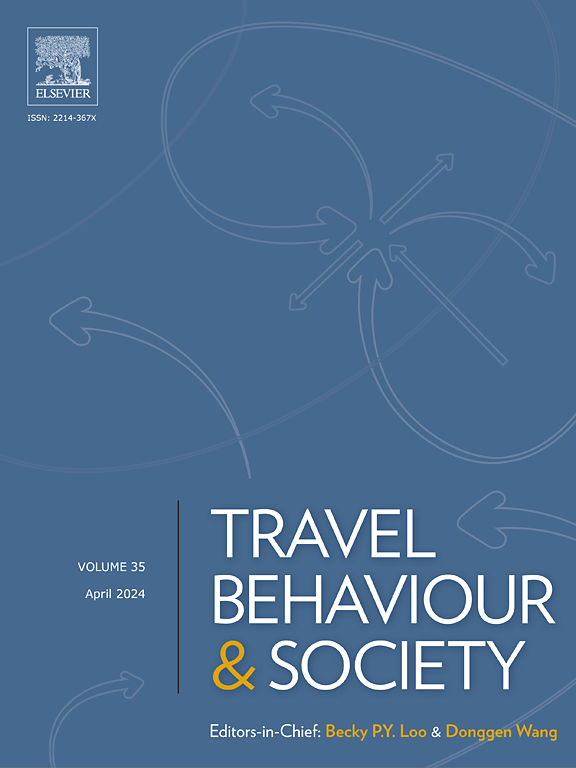Complementary intermodal commuting and resident travel satisfaction: A nonlinear and interaction analysis
IF 5.7
2区 工程技术
Q1 TRANSPORTATION
引用次数: 0
Abstract
While many studies focus on single-mode satisfaction drivers, few examine how intermodal commuting affects commuter travel satisfaction and efficiency in urban settings. This study investigates how complementary intermodal commuting—where multiple modes of transportation are used in a single journey—affects travel satisfaction in Shanghai. Using an XGBoost model, we specifically explore how intermodal commuting and its interactions with contextual factors, like trip characteristics and sociodemographic features, influence travel satisfaction. Data was collected from the 2018 Shanghai Urban Resident Survey, with 1,052 respondents. The results show that while the number of commuting modes (NUMOD) and types of mode combinations (TYPMOD) affect satisfaction, commuter seamlessness (fewer delays and interruptions) and commute time (COMTIM) are the most influential factors. Nonlinear analyses show that active travel-dominated combinations (Type 7) are linked to higher satisfaction, while public transit-dominant combinations (Type 5) in China often correlate with lower satisfaction due to overcrowding. Private car-involved combinations (Types 1 and 3) mainly impact long-distance commutes. Nonlinear interaction analyses further reveal that the interaction between intermodal commuting and trip characteristics has an enhanced effect on commuter satisfaction. Overall, this research provides valuable insights into the complex dynamics between intermodal commuting and travel satisfaction, beyond traditional linear analyses. It also offers meaningful guidance for devising rational transportation policies under intermodal commuting conditions.
互补性多式联运通勤与居民出行满意度:非线性交互分析
虽然许多研究关注的是单模式的满意度驱动因素,但很少有人研究多式联运通勤如何影响城市环境下的通勤出行满意度和效率。本研究探讨了互补式多式联运通勤(在一次行程中使用多种交通方式)如何影响上海的旅行满意度。使用XGBoost模型,我们具体探讨了多式联运通勤及其与环境因素(如旅行特征和社会人口特征)的相互作用如何影响旅行满意度。数据来自2018年上海城市居民调查,共有1052名受访者。结果表明:通勤方式数量(NUMOD)和通勤方式组合类型(TYPMOD)影响满意度,而通勤无缝性(较少的延迟和中断)和通勤时间(COMTIM)是影响满意度的主要因素。非线性分析表明,主动出行为主的组合(类型7)与较高的满意度相关,而中国公共交通为主的组合(类型5)往往与由于过度拥挤而导致的较低满意度相关。私家车出行组合(类型1和类型3)主要影响长途通勤。非线性交互分析进一步揭示了多式联运通勤与出行特征之间的交互作用对通勤者满意度的影响增强。总的来说,这项研究超越了传统的线性分析,为多式联运通勤和旅行满意度之间的复杂动态关系提供了有价值的见解。为多式联运通勤条件下制定合理的交通政策提供了有意义的指导。
本文章由计算机程序翻译,如有差异,请以英文原文为准。
求助全文
约1分钟内获得全文
求助全文
来源期刊

Travel Behaviour and Society
TRANSPORTATION-
CiteScore
9.80
自引率
7.70%
发文量
109
期刊介绍:
Travel Behaviour and Society is an interdisciplinary journal publishing high-quality original papers which report leading edge research in theories, methodologies and applications concerning transportation issues and challenges which involve the social and spatial dimensions. In particular, it provides a discussion forum for major research in travel behaviour, transportation infrastructure, transportation and environmental issues, mobility and social sustainability, transportation geographic information systems (TGIS), transportation and quality of life, transportation data collection and analysis, etc.
 求助内容:
求助内容: 应助结果提醒方式:
应助结果提醒方式:


